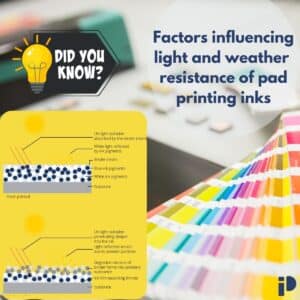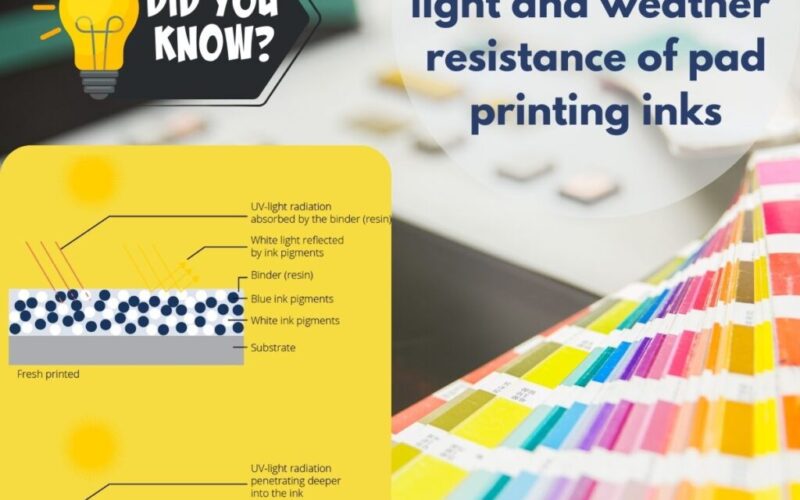Factors influencing light and weather resistance of pad printing inks
LIGHT AND WEATHER RESISTANCE
OF PAD PRINTING INKS
Unlike other printing methods, pad printing stand out for its remarkable qualities: they offer exceptional mechanical and chemical durability and excellent light and weather fastness. However, pad printing inks must meet stricter quality standards, such as high resistance to multi-layer printing and to coloured plastic materials. They often have to withstand outdoor conditions for several years. To meet these higher standards, pad printers have to consider several factors.
Essentially, any outdoor print will inevitably degrade over time. Despite the quality and stability of the colour layer, prolonged exposure to sunlight, particularly UV radiation, and various weather elements like humidity, temperature shifts, and atmospheric components (such as salt or exhaust fumes), will contribute to its degradation. Printers can only attempt to prolong this deterioration by employing the highest quality materials available.
Factors affecting light and weather resistance of pad printing inks
- Substrate
- Pigment
- Ink type
- Colour
- Layer thickness
- Protection
Substrate
It all starts with the substrate of the product to be printed. If the substrate is not weatherproof, neither will the ink applied. The degradation of the substrate will cause the applied ink to decompose from below. So the first step is to choose a substrate that meets the required weather resistance requirements. A standard polystyrene board, for example, shows noticeable yellowing within a few weeks, and this yellowing gets progressively worse over time. Moreover, it becomes brittle after only a few months of exposure. Polyester film, as used for e.g. membrane switches, is also only suitable to a limited extent. UV light from the sun can cause significant discolouration within a few months
PVC-materials have different properties. Hard PVC usually has an outdoor durability of 1 year, while high-quality self-adhesive PVC films can even last more than 10 years in outdoor applications. PMMA, better known as acrylic glass or marketed as Plexiglas, has exceptional resistance to light and weathering. The fact that PMMA absorbs UV light will also significantly extend the life of inks printed on the backside.
Pigment
The colors of our pad printing inks are produced with pigments. In general, we use only particularly lightfast pigments (6 – 8 according to the Blue Wool Standard or Scale). With the exception of fluorescent pigments, which generally have limited color fastness. Our pigments provide the basis for prints that retain their colour for a long time. The biggest threat to pigment stability is the intense UV radiation from sunlight, which degrades and destroys these pigments over time. Therefore, the color stability of pigments should always be related to the duration and intensity of sunlight exposure. Of course, conditions vary depending on climate. Certain blue pigments are the most resistant to UV radiation, while yellow and red pigments are slightly less resistant. Under specific conditions, even white pigments (such as titanium dioxide) can adversely affect color fastness and resistance to weathering.
The Blue Wool Scale typically consists of a series of standardised colour samples, each made with a specific dye or pigment. These samples are exposed to controlled light conditions for a specified period of time, and their fading or colour change is compared to a scale. The scale is divided into different levels or steps from 0 to 8, with higher numbers indicating greater lightfastness or resistance. The Blue Wool Scale helps manufacturers assess the longevity of colour materials and make informed decisions about materials and techniques to ensure objects retain their original appearance over time. Zero indicates extremely poor colour fastness, while an eight is considered unchanged from the original and thus credited as lightfast and durable. The ultraviolet (UV) radiation in light is responsible for ink fading. Since the intensity of UV radiation varies from place to place, ink colour fading also depends on location. It will be more in areas with more UV radiation and vice versa. This difficulty is overcome by the blue-wool test method. Absolute values of fading will depend on light intensity. Relative values of fading, comparing the sample to the standard blue test strip, will depend less on intensity. For example, if a pigment is rated as “BW5”, it can be expected to fade to the same extent as strip number 5 on a blue wool test chart at a specific light exposure. The comparison method between the sample and a test strip allows accelerated testing under intense artificial lighting.
Colour
Colour or colour mixing is another decisive factor for long-term colour stability. Take our MX colour range as an example, these are 12 strong and brilliant colours with medium to high transparency, suitable for mixing PMS, HKS and RAL colours on white substrates. Each colour contains only one pigment. Those basic colours, used with the right ink gamut, are ideal for long-term out[1]door printing.. The higher the white or varnish content in an ink is, the shorter the light and weather resistance of the prints will be. A high white content (> 20%) in an ink mixture increases the tendency to chalk. The more white there is in the ink, the greater the risk of chalking. The weather affects the white pigmentation which, due to a photochemical reaction, forms a disturbing, mealy, milky-white chalk layer on the surface of the printed ink layer. Therefore, highly opaque white colours are not recom[1]mended for long-term outdoor applications. This effect does not only occur in pad printing. It is a common problem in almost all coating technologies, such as, for example, on commercial buildings covered with corrugated metal sheets that are colour-coated. If these plates are light blue in colour, after about 3 to 4 years, more scale will appear on parts of the building exposed to significant light and weather influences than on parts in the shade.
Light and weather resistance test
To gather essential data regarding substrate properties, ink varieties, and colors, test prints typically undergo outdoor weathering or accelerated weathering processes. Open-air tests involve exposing proofs to natural light and weather conditions for several years, which makes it difficult to obtain reliable test results
Layer thickness
Besides pure and intense colours, you can also achieve better resistance to weathering by using a high film thickness. The thicker, the better. Cars or metal building facades are coated in multiple layers of up to 100μ. Multiple pad printing layers (2 – 3 times) with optimal ink transfer can reach 20μ. Protection You can protect the printed ink layer with varnishes containing UV-protective additives. However, no significant effect of absorption of UV radiation will occur un[1]less you apply the protective coating with a layer thickness between 50μ and 100μ. On the other hand, depending on the ink type used, a protective coating can also have unwanted side effects, such as the varnish layer becoming cloudy. However, in some individual cases, a protective coating may be suitable to protect the ink layer from mechanical damage and mainly dirt.
Protection
You can protect the printed ink layer with varnishes containing UV-protective additives. However, no significant effect of absorption of UV radiation will occur unless you apply the protective coating with a layer thickness between 50μ and 100μ.On the other hand, depending on the ink type used, a protective coating can also have unwanted side efects, such as the varnish layer becoming cloudy. However, in some individal cases, a protective coating may be suitable to protect the ink layer from mechanical damage and mainly dirt.
Check out the inks we offer and advice on ink selection from our experienced experts hier






